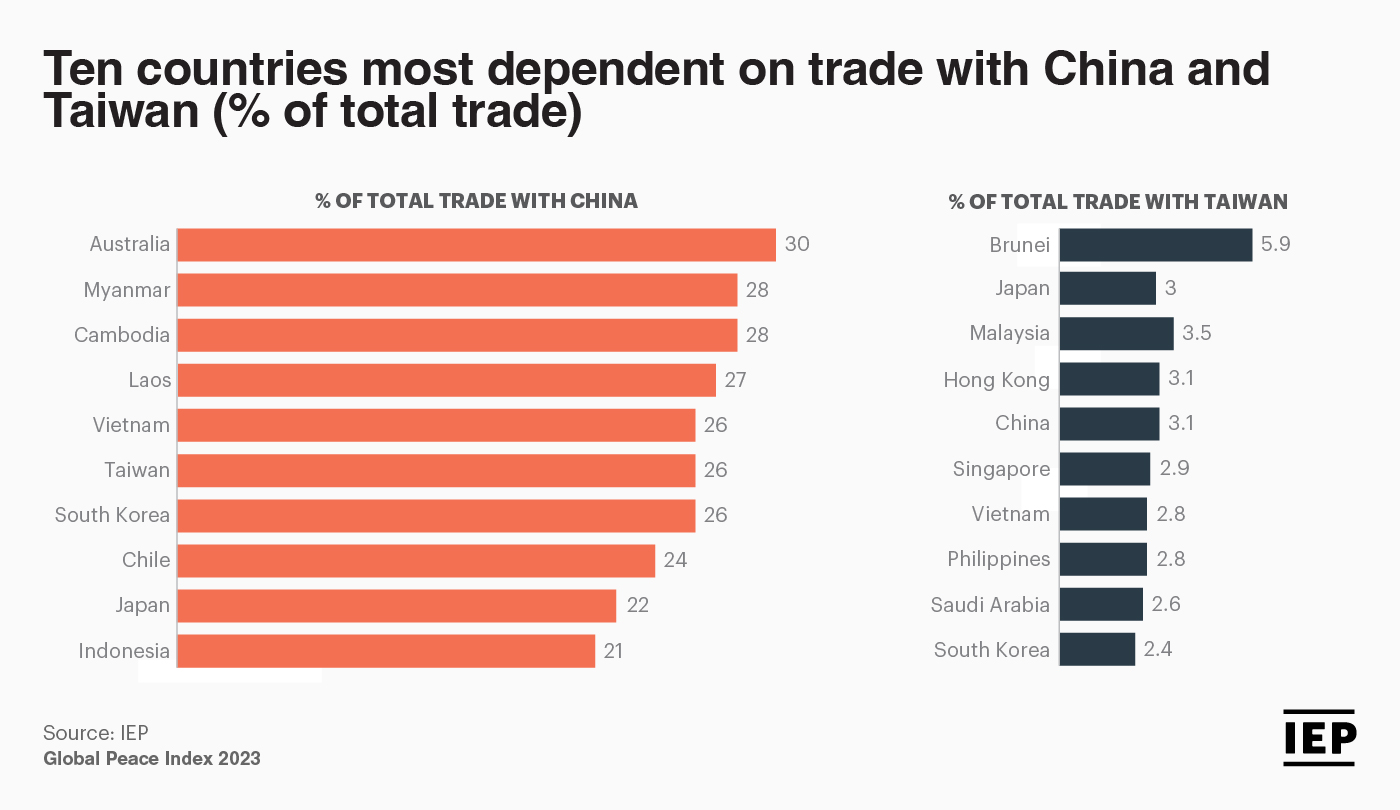As tensions escalate between Taiwan and China, the Institute for Economics & Peace (IEP) has delved into the uncertainties surrounding the effects of this conflict on GDP and global supply chain demands in the recently published Global Peace Index (GPI). Taiwan, officially known as the Republic of China (ROC), remains an independent state, while China, referred to as the People’s Republic of China (PRC), seeks reunification, perceiving Taiwan as part of its territory. Although the PRC claims to pursue reunification through peaceful means, tensions persist on both sides, causing concern among the international community. China’s military prowess, which surpasses Taiwan’s capabilities has prompted scrutiny of its potential military strategies, raising doubts about peaceful intentions.
China’s display of military might and intimidation tactics has contributed to the rising tensions. Despite asserting a commitment to peaceful reunification, China’s military expenditure has been increasing, with significant investments in defence weapons and military growth. In contrast, Taiwan faces financial constraints and lacks comparable resources to counterbalance China’s power. The international community is closely monitoring China’s actions, as incidents like the recent Chinese military aircrafts that flew into the territorial area of Taiwan raise further concerns about potential conflicts.
According to the IEP, a Chinese blockade of Taiwan would result in a staggering estimated loss of USD 2.7 trillion within the first year. However, this figure is considered conservative, suggesting that the actual economic impact could be even more substantial. The blockade would have a profound effect on numerous Southeast Asian countries, causing significant disruptions across their economies. Specifically, IEP estimates a 2.8% decline in global economic output, almost double the loss experienced during the 2008 Global Financial Crisis. China’s economy would shrink by an estimated 7%, while Taiwan’s economy would face a devastating contraction of almost 40%.
Taiwan holds a prominent position in the global semiconductor industry, manufacturing chips that serve as vital components in various technologies, ranging from mobile phones to computers and even AI-powered weapons. In fact, Taiwan is a global leader in semiconductor production, boasting a 20% share of the total global capacity. Moreover, it holds a staggering 37% of the world’s logic semiconductors production capacity and an astonishing 92% of the world’s advanced logic semiconductors production capacity. This dominance makes Taiwan a crucial player in global trade for computers, electronics, and electrical equipment. China and several East Asian countries, including South Korea and Japan, heavily rely on imports of computer and electronic components from Taiwan. For example, the share of trade with Taiwan in this sector ranges from 10% for the Philippines to 21% for China. That is why a blockade on Taiwan would severely disrupt global supply chains, impacting industries that rely on complex electronics.

IEP estimates that the blockade would result in a 2.8% decline in global economic output within the first year, with China and Taiwan combined experiencing a loss of $1.6 trillion in output. This loss would not only be confined to the two countries but would also be strongly felt in other parts of the world, particularly in Southeast Asia and Oceania. Countries in these regions, such as Australia, Laos, and Vietnam, would suffer economic losses ranging from 3% to 6%.
The escalating tensions between Taiwan and China have the potential to impact not only the two nations but also the global economy and supply chains. IEP’s estimates highlight the significant economic losses that could ensue from a Chinese blockade on Taiwan, underscoring the need for diplomatic efforts and peaceful resolutions to mitigate the potential consequences. The world watches with concern as the delicate balance in this region teeters, hoping for a peaceful resolution that safeguards stability and economic prosperity for all parties involved. The reliance on Taiwan’s semiconductor industry and its crucial role in global supply chains make it imperative to address the potential consequences of a Chinese blockade.
The significance of Taiwan’s semiconductor industry extends far beyond its borders. Major economies, including the United States, heavily depend on Taiwan for the supply of semiconductors. Prominent tech companies like Apple rely on Taiwanese manufacturers to meet the demands of their products. However, if a blockade were to occur, it would disrupt the global supply chain for computers, electronics, and electrical equipment, which collectively account for a significant portion of international trade. China and Taiwan combined dominate the global trade in these sectors, with a 31% share in computers and electronics and a 23% share in electrical equipment.

A Chinese blockade on Taiwan would have far-reaching consequences for the global economy. The estimated economic losses, already substantial, would likely be even more significant than initially predicted. The disruption to global supply chains, particularly in the vital semiconductor industry, would have cascading effects on various sectors and industries worldwide. It is essential for all parties involved to seek diplomatic resolutions and peaceful means of addressing the tensions between Taiwan and China to preserve stability, economic prosperity, and the interconnectedness of the global economy.

Download the Global Peace Index 2023.
Global Peace Index 2023